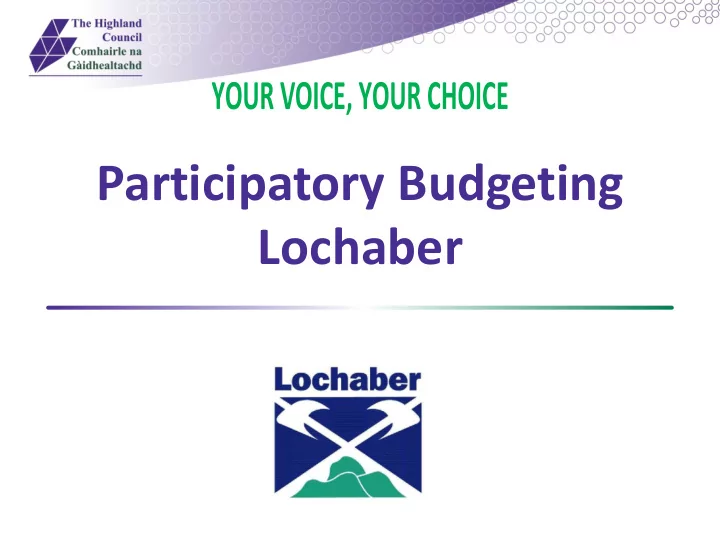

YOUR VOICE, YOUR CHOICE Participatory Budgeting Lochaber
YOUR VOICE, YOUR CHOICE
YOUR VOICE, YOUR CHOICE Headlines • 1,279 people participated casting over 2,243 eligible votes • People aged 11 – 87 years from a broad demographic and geographical spread got involved in the discussion and decision making process. • Our young people told us how they wanted to connect and interact with us. We did it their way! • We made new connections with our ‘seldom heard’ and ‘harder to reach’ young people ( and others). • We used a new and distinct approach which people embraced.
YOUR VOICE, YOUR CHOICE How we did it – the practical bits We worked with a core steering group supported by our community planning partners. Young people were our point of reference. 4 stages 1. Call for proposals 2. Pre-assessment of bids 3. On-line and postal voting 4. Young people’s panel in each associated school group (ILC) area.
YOUR VOICE, YOUR CHOICE The on-line and postal voting age profile showed a strong voting turnout from young people but also shows the broad age range engaged in the process.
Young people’s assessment panels • 25% weighting • 4 panels – one in each of our associated school group areas (Individual learning communities) • 6-7 young people on each panel • A member of Highlife Highland staff was on hand for each of the panels to ensure the young people were supported in the process
Learning and next steps Positives - People liked and embraced ‘virtual PB’ - We reached new people - The area had a buzz about it – people were talking, connecting, deliberating Negatives - The assessment panel approach with weighting did not produce a great result for one community. There were a number of factors at play which we now understand better. Next steps - Look at delivering PB at that very ‘local’ (associated school group) level to make it as meaningful as possible – particularly when looking at young people’s services. - Look at using other ‘platforms’ for voting and discussion eg – young scot card, on- line community forums
Summary overview Communities can build on existing and active social media platforms that people in the community are currently using. If people respond to e-mail blasts, use them. If youth are using Instagram, use it. Communities should be encouraged to try new approaches – we did it, they embraced it! Communities can identify ways to turn passive observers on social media platforms into active participants. Social media platforms are not top-down processes, but collaborative, two-way forms of communication. People can connect across geographical areas and see the impact of the whole process. Using a combination of traditional community engagement approaches with multiple social media platforms works. Don’t be afraid to use different approaches.
Questions 1. What are critical measures of success in a youth PB process? 2. What is an appropriate level of monitoring and evaluation for a youth PB process ? 3. How do you ensure dialogue and deliberation take place when using multi channel processes? 4. As we look to escalate PB how do we continue to engage young people ?
Recommend
More recommend